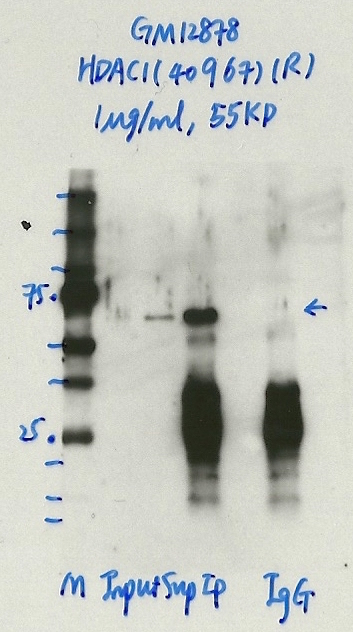ENCAB508CZJ
Antibody against Homo sapiens HDAC1
Homo sapiens
K562, MCF-7, GM12878
characterized to standards
Homo sapiens
any cell type or tissue
partially characterized
- Status
- released
- Source (vendor)
- Active Motif
- Product ID
- 40967
- Lot ID
- 04214009
- Characterized targets
- HDAC1 (Homo sapiens)
- Host
- rabbit
- Clonality
- polyclonal
- Purification
- affinity
- Aliases
- michael-snyder:AS-855
- External resources
Characterizations
HDAC1 (Homo sapiens)
GM12878
compliant
- Caption
- Immunoprecipitation was performed on nuclear extracts from the cell line: GM12878, using the antibody 40967. The blot shows western blot analysis of input, flowthrough, immunoprecipitate and mock immunoprecipitate using IgG.Molecular Weight: 55.103
- Submitted by
- Denis Salins
- Lab
- Michael Snyder, Stanford
- Grant
- U54HG006996
- Download
- 1064_4_HDAC1_40967_GM12878.jpg
HDAC1 (Homo sapiens)
not submitted for review by lab
- Caption
- Immunoprecipitation was performed on nuclear extracts from the cell line: HepG2, using the antibody 40967. The blot shows western blot analysis of input, flowthrough, immunoprecipitate and mock immunoprecipitate using IgG.Molecular Weight: 55.103
- Submitted by
- Denis Salins
- Lab
- Michael Snyder, Stanford
- Grant
- U54HG006996
- Download
- 1064_5_HDAC1_40967_HepG2.jpg
HDAC1 (Homo sapiens)
MCF-7
compliant
- Caption
- Immunoprecipitation was performed on nuclear extracts from the cell line: MCF-7, using the antibody 40967. The blot shows western blot analysis of input, flowthrough, immunoprecipitate and mock immunoprecipitate using IgG.Molecular Weight: 55.103
- Submitted by
- Denis Salins
- Lab
- Michael Snyder, Stanford
- Grant
- U54HG006996
- Download
- 1064_6_HDAC1_40967_MCF7.jpg
HDAC1 (Homo sapiens)
K562
compliant
- Caption
- Immunoprecipitation was performed on nuclear extracts from the cell line: K562, using the antibody 40967. The blot shows western blot analysis of input, flowthrough, immunoprecipitate and mock immunoprecipitate using IgG.
- Submitted by
- Denis Salins
- Lab
- Michael Snyder, Stanford
- Grant
- U54HG006996
- Download
- Expt 825_6-HDAC1.jpg
HDAC1 (Homo sapiens)
K562
compliant
- Caption
- Immunoprecipitation of HDAC1 from K562 cells using 40967. Lane 1: input nuclear lysate. Lane 2: material immunoprecipitated with 40967. Lane 3: material immunoprecipitated using control IgG. Band A was excised from gel and subject to analysis by mass spectrometry. The expected band size is 55 kDa.
- Submitted by
- Kathrina Onate
- Lab
- Michael Snyder, Stanford
- Grant
- U54HG006996
- Download
- HDAC1 (2).jpg
HDAC1 (Homo sapiens)
Method: immunoprecipitation followed by mass spectrometry
compliant
- Caption
- IP followed by mass spectrometry: Briefly, protein was immunoprecipitated from K562 nuclear cell lysates using 40967, and the IP fraction was loaded on a 10% polyacrylamide gel (NuPAGEBis-Tris Gel) and separated with an Invitrogen NuPAGE electrophoresis system. The gel was stained by ColloidialCoomassie G-250 stain, gel fragments corresponding to the bands indicated were excised. Then proteins were trypsinized using the in-gel digestion method. Digested proteins were analyzed on an Orbitrap Elite mass spectrometer (Thermo Scientific) by the nanoLC-ESI-MS/MS technique. Peptides were identified by the SEQUEST algorithm and filtered with a high confidence threshold (Peptide false discovery rate < 1%, 2 unique peptides per protein minimum, mass error < 10 ppm).
- Submitter comment
- For this factor, we found two other TF (MTA2 and GATAD2A) has more peptides than targeted protein. Explanation: http://www.genecards.org/cgi-bin/carddisp.pl?gene=GATAD2A&keywords=gatad2a shows that GATAD2A has interaction with MTA2, and http://www.genecards.org/cgi-bin/carddisp.pl?gene=HDAC1&keywords=hdac1 indicated that MTA2 and HDAC1 can form core complex.
- Submitted by
- Kathrina Onate
- Lab
- Michael Snyder, Stanford
- Grant
- U54HG006996
- Download
- HDAC1_40967 final HDAC1_40967.pdf




